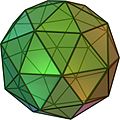This article is currently slated for merging. There is consensus to merge this article into Geodesic polyhedron . You can carry out the merge by following the resolution at the discussion and the merging instructions. Process started June 2025. |
| Pentakis icosidodecahedron | |
|---|---|
 | |
| Type | Geodesic polyhedron (2,0) |
| Faces | 80 triangles (20 equilateral; 60 isosceles) |
| Edges | 120 (2 types) |
| Vertices | 42 (2 types) |
| Vertex configuration | (12) 35 (30) 36 |
| Conway notation | k5aD = dcD = uI |
| Symmetry group | Icosahedral (Ih) |
| Dual polyhedron | Chamfered dodecahedron |
| Properties | convex |
| Net | |
 | |
In geometry, the pentakis icosidodecahedron or subdivided icosahedron is a convex polyhedron with 80 triangular faces, 120 edges, and 42 vertices. It is a dual of the truncated rhombic triacontahedron (chamfered dodecahedron).








